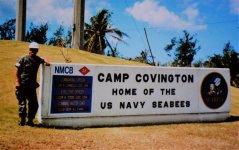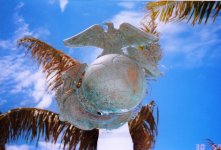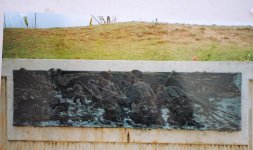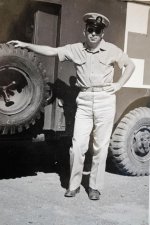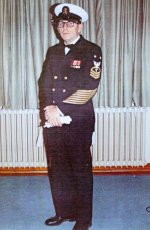OLDNAVYMCPO
US Veteran, Absent Comrade
The skinny kid walked along the railroad tracks daydreaming and unconsciously kicking at the ballast rocks with his worn boondockers. He was the product of the depression and borderline poverty. His father worked as a laborer at the Gulf Ice Company. With only a third grade education that was the best his father could do but at least he had a job. Times were hard. The war was four months old. The Japs had attacked Pearl Harbor on December 7, 1941.
Today was March 23,1942, Carl's seventeenth birthday. A really big day, he had quit high school. This was maybe the most important day of his life. His Mama had finally relented and signed the papers for him to enlist. In just minutes he would see the recruiter and join the Navy. The Navy for sure, what else, he had grown up in Pensacola. Carl had tried to join earlier, right after Pearl Harbor, lied about his age, took the physical, even signed all the papers. Then his mom showed up at the recruiting station, threw a hissy-fit and dragged him home.
Navy bootcamp, hospital corpsman school, training with the Marines as a combat corpsman then assigned to the 3rd Marine Division. He went ashore with them for the invasion of Bougainville in November of 1943. Cary's baptism of fire. He was a man now, hardened by the training and the combat.
As part of the island hopping campaign, Guam was on the list of islands to be retaken from the Japanese. The Japs had invaded this U.S. possession on 10 Dec 1941. U.S. Naval and air bombardment began on 11 June 1944. From 14-17 July, Navy Underwater Demolition Teams reconned the planned landing beaches and removed obstacles.
On 21 July 1944, American Marines commenced landings. The 3rd Marine Division landed near Agana and the 1st Provisional Marine Brigade landed near Agat. Asan beach lies between the two. Cary was one of the first 100 men to come ashore with the 1st Provisional Marine Brigade.
Japanese heavy artillery inflicted heavy causalities upon the landing troops. Over the next several days Jap troops infiltrated Marine lines but were repeatedly driven back with heavy losses. On 28 July the two beachheads were united and a day later the peninsula was secured. On 10 Aug., organized Jap resistance ended.
Guam was turned into a base of operations. The Navy Seabees built five large airfields. The U.S. suffered 7000 casualties, 1747 KIA and 6053 wounded. The Japanese had over 18,000 killed. Four Marines were awarded the MoH.
In 2002, on active duty with the Navy Seabees, I was tasked with conducting inspections of all Seabee construction in the Pacific. The Seabees have a major presence on Guam. I had the opportunity to stand on Asan Ridge and look down on the beaches where my father's younger brother had come ashore as a combat corpsman.
PHOTOS: 1) me at HQ pacific
2) me at Camp Covington
3) Memorial to Marines at Asan Beach
4) War memorial at Asan Ridge
5) looking down to beach, the Japs made a last desperate Banzai charge down this draw.
Today was March 23,1942, Carl's seventeenth birthday. A really big day, he had quit high school. This was maybe the most important day of his life. His Mama had finally relented and signed the papers for him to enlist. In just minutes he would see the recruiter and join the Navy. The Navy for sure, what else, he had grown up in Pensacola. Carl had tried to join earlier, right after Pearl Harbor, lied about his age, took the physical, even signed all the papers. Then his mom showed up at the recruiting station, threw a hissy-fit and dragged him home.
Navy bootcamp, hospital corpsman school, training with the Marines as a combat corpsman then assigned to the 3rd Marine Division. He went ashore with them for the invasion of Bougainville in November of 1943. Cary's baptism of fire. He was a man now, hardened by the training and the combat.
As part of the island hopping campaign, Guam was on the list of islands to be retaken from the Japanese. The Japs had invaded this U.S. possession on 10 Dec 1941. U.S. Naval and air bombardment began on 11 June 1944. From 14-17 July, Navy Underwater Demolition Teams reconned the planned landing beaches and removed obstacles.
On 21 July 1944, American Marines commenced landings. The 3rd Marine Division landed near Agana and the 1st Provisional Marine Brigade landed near Agat. Asan beach lies between the two. Cary was one of the first 100 men to come ashore with the 1st Provisional Marine Brigade.
Japanese heavy artillery inflicted heavy causalities upon the landing troops. Over the next several days Jap troops infiltrated Marine lines but were repeatedly driven back with heavy losses. On 28 July the two beachheads were united and a day later the peninsula was secured. On 10 Aug., organized Jap resistance ended.
Guam was turned into a base of operations. The Navy Seabees built five large airfields. The U.S. suffered 7000 casualties, 1747 KIA and 6053 wounded. The Japanese had over 18,000 killed. Four Marines were awarded the MoH.
In 2002, on active duty with the Navy Seabees, I was tasked with conducting inspections of all Seabee construction in the Pacific. The Seabees have a major presence on Guam. I had the opportunity to stand on Asan Ridge and look down on the beaches where my father's younger brother had come ashore as a combat corpsman.
PHOTOS: 1) me at HQ pacific
2) me at Camp Covington
3) Memorial to Marines at Asan Beach
4) War memorial at Asan Ridge
5) looking down to beach, the Japs made a last desperate Banzai charge down this draw.


